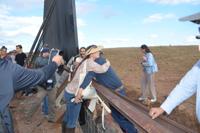
Getty Images
For every dollar a white, non-Hispanic man makes, a Latina living in Arizona makes just 54.5 cents.
On the 10th anniversary of Latina Equal Pay Day — a national campaign launched in 2015 to bring attention and help achieve pay parity for this sector of the population — a new report from the Institute for Women’s Policy Research shows just how little has changed in that decade of advocacy for better pay.
“For a decade, we’ve been tracking the wage gap for Latinas, and despite progress, their pay still hovers barely past half that of white men. The gap won’t close for well over a century,” Dr. Martha Susana Jaimes, senior research economist at IWPR, said in a statement released on Oct. 8. “These numbers not only tell a story about economic disparities, but about the values that our larger society places on the type of work Latinas often do — low-wage jobs with very few workplace protections, such as farm work, child and elder care, and domestic and hospitality work. This, coupled with the current racist attacks on immigrant communities, only deepens the structural economic inequities faced by Latinas and their families.”
Nationally, the report found that all Latinas are paid 54.1 cents for every dollar paid to white, non-Hispanic men, while full-time, year-round Latina workers earn 58 cents for every dollar.
Since 2015, the national average has remained between 50 and 60 cents.
According to the report, the Grand Canyon State ranked 14th, where all working Latinas are paid 54.5 cents for every dollar a white, non-Hispanic man makes. Latinas who work full-time year-round are paid 57.1 cents to the dollar, placing the state at 28th place, even lower among the 50 states and the District of Columbia.
Latinas, who in 2022 made up the second-largest female labor force after Black women, according to the Latino Policy & Politics Institute at UCLA, continue to be the lowest paid in the nation. According to IWPR, this stems from systemic inequities that include discriminatory practices, education gaps and overrepresentation in lower-paid fields.
And when it comes to Latinas living in rural communities or who are foreign-born, the gap becomes larger. In 2024, Latinas in rural areas were paid just 43 cents on the dollar, while Latina immigrants born in Mexico, Guatemala or Honduras were paid less than 35 cents on the dollar.
Policy and advocacy are needed
Stephanie Vasquez, owner of Fair Trade Café in Phoenix, founded E.L.L.A., or Empowering Latina Leaders in Arizona, as a direct result of the Latina pay gap that negatively impacts her community.
She founded E.L.L.A. in 2018 to help “counter the negative aspects of Latina Equal Pay Day by highlighting and celebrating Latinas' successes.” The organization achieves this by hosting Mujeres Mercado, a Valley-wide market that showcases local businesses owned and run by members of the Latino community, a majority of whom are women.
Other programs have flourished from E.L.L.A. as well, like Amor Collective, an incubator space that assists Latina entrepreneurs in launching their small businesses by offering them a shared storefront, mentorship and community, and Amor Amigas, a networking space for Valley Latinas.
But programs like these are not enough to help close the gap, the report suggests.
The consequences of the wage gap will result in the loss of $1.2 million in earnings over the course of a 40-year career for a typical Latina working full-time year-round, the report states. Due to the lack of policy in place to help fill that gap and trends analyzed since 2022, it will take over a century — until the year 2160 — to fully achieve payment equity for this sector of the population that works full-time, the report states.
The IWPR suggests enacting comprehensive policies that “prioritize fair participation in the labor force, pay equity and long-term economic stability for Latinas," to help fill the gap.
That includes passing legislation that counters pay inequity, discrimination and harassment in the workplace; promotes salary transparency and prohibits compensation based on salary history; improves access to paid leave and protections from retaliation and increases investment in access to healthcare and education.











(0) comments
Welcome to the discussion.
Log In
Keep it Clean. Please avoid obscene, vulgar, lewd, racist or sexually-oriented language.
PLEASE TURN OFF YOUR CAPS LOCK.
Don't Threaten. Threats of harming another person will not be tolerated.
Be Truthful. Don't knowingly lie about anyone or anything.
Be Nice. No racism, sexism or any sort of -ism that is degrading to another person.
Be Proactive. Use the 'Report' link on each comment to let us know of abusive posts.
Share with Us. We'd love to hear eyewitness accounts, the history behind an article.